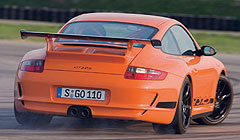Make / Model Search
News - PorschePorsche's one-track mindNew flagship: Four-door Panamera (sketched above, with the GT3 RS) is expected to add at least 20,000 vehicle sales annually. Porsche looks to 100,000 sales but pins its future on profitability and exclusivity18 Aug 2006 MAINTAINING profitability and exclusivity have become Porsche’s new internal catchcries as the company looks to break the 100,000-sales-a-year mark for the first time ever by the end of this decade. The famed German sportscar brand sold around 90,000 vehicles in the model year that ended on July 31, but says its fourth model line – the four-door Panamera V8 sedan due on sale in 2009 – will represent the marque’s next big sales volume increase. "The 100,000-mark is an interesting threshold but not one of great importance," Porsche’s international press advisor Michael Schimpke told GoAuto. "What’s important is how much money we make."Mr Schimpke said protecting Porsche resale values by resisting discounting and limiting supply was the key to sustained profits. "We’ll definitely sell more than 100,000 vehicles annually within five years, but don’t expect leaps and bounds. We will always build one less vehicle than is demanded."Although a minimum of 20,000 annual Panamera sales will easily push Porsche past the 100,000 mark in 2009, Porsche says no further model expansions are planned and is adamant a second SUV, based on Audi’s forthcoming Q5 compact off-roader, will not eventuate. "Panamera will give us another different clientele, but Porsche itself doesn’t know the natural size of the company. Some say Porsche needs yet another clientele but we’re not scratching for it. We don’t have this in mind. "Will we have another SUV version? No, we will not. It would be very easy to be sucked into it, but we will avoid it," he said. While a small SUV appears to be off limits, Porsche is quick to point out that the original Boxster (1997), the previous 996-series 911 (1998) and the Cayenne SUV (2002), which last year accounted for almost half of all Porsche sales, were integral to Porsche’s turnaround from the brink of extinction in the early 1990s. "The irony is that we’ve become a two-sportscar company because of Cayenne, not despite of it," says 22-year Porsche veteran and Porsche Cars Australia’s managing director since 1995, Michael Winkler. "Cayenne has allowed us to remain independent."  Mr Winkler said the lack of a future product strategy and slow western-market sales saw Porsche slide "closer than any of will ever know" toward bankruptcy in 1991-1992. Mr Winkler said the lack of a future product strategy and slow western-market sales saw Porsche slide "closer than any of will ever know" toward bankruptcy in 1991-1992.He said a subsequent Piech/Porsche family investment to develop Boxster – and the decision to produce Cayenne in a joint-development deal with Volkswagen, rather than co-develop an ML-based SUV with DaimlerChrysler in return for a shareholding in Porsche – were instrumental in the brand’s survival. Since then Porsche has become Volkswagen’s largest individual shareholder, Porsche’s sales and profits have increased every year for more than a decade and Cayenne has established itself as a key Porsche model despite criticism by observers, especially within Australia, who predicted Porsche’s first off-roader would ruin the sports car maker’s brand image. Although Mr Winkler said a concerted sales push during the changeover from the 996 to 997-series 911 last year "had an immediate effect on resale values" and caused PCA to "back off", the local MD says Australians now appear ready to embrace a V6 version of Cayenne – which appears likely to be sold here for the first time next year as part of a facelifted SUV model line-up. "I think the fact that Cayenne has established itself in the market makes the decision (to introduce a V6 variant) so much easier," he told GoAuto. "I think a V6 Cayenne at around $100,000 would be successful."A sub-$100,000 pricetag would make the 184kW/310Nm 3.2-litre Cayenne the least expensive model in Porsche’s line-up, and Mr Winkler said additional annual sales of about 200 examples a year could be expected, with around 50 being substitutional for the V8-powered Cayenne S. After four years on sale, Cayenne’s popularity in Australia has dropped from a high of 562 sales in 2004 to 414 last year and, with the SUV Over $100,000 segment down 10 per cent year-on-year, is expected to fall further this year. With the facelifted Cayenne range not expected to appear until next year’s Frankfurt motor show, Mr Winkler stressed a V6 decision won’t be made until late this year. Before then, PCA will undertake the unprecedented rapid-fire release of a new 911 Turbo, new 911 GT3/RS and new 911 Targa models, plus an upgraded Boxster range and the new entry-level Cayman 2.7 coupe.
|
Click to sharePorsche articlesResearch Porsche Motor industry news |
||||||||||||||||||||||||









Facebook Twitter Instagram